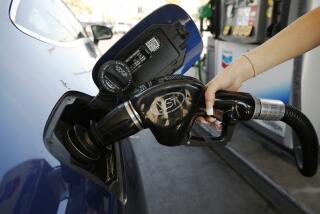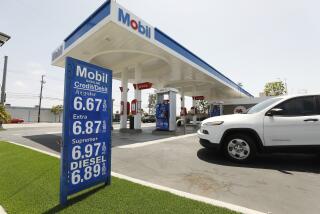Gas Prices Headed to $2 a Gallon, Analysts Say
- Share via
Get ready to pay $2 a gallon for gasoline.
Retail gasoline prices in California and nationwide hit new highs Monday as the U.S. Energy Department released a gloomy forecast that pump prices around the country could approach $1.80 a gallon this summer even if OPEC decides to increase production of crude oil.
In California--where self-serve regular unleaded gasoline has risen 11.5 cents in the last week to a record average of $1.63 a gallon--$1.80 may look cheap by June.
That’s because the state’s cleaner-burning gasoline usually runs about a dime a gallon more than the conventional fuel sold elsewhere, and some analysts predict that conventional gasoline will become much more expensive than even the government’s most pessimistic prognosis.
If these predictions come close to being true, gasoline prices figure to become a hot political issue in the months ahead. They are already creating some concern about economic growth.
Monday’s government forecast validates what oil speculators and buyers have been saying for months, as the price of crude has jumped from about $25 in December to nine-year highs above $30 in recent weeks. West Texas intermediate crude for April delivery closed at $32.18 Monday on the New York Mercantile Exchange, the highest closing price since November 1990.
The U.S. average price of self-serve regular unleaded gasoline was $1.50 a gallon Monday, an Energy Department survey of 800 gasoline stations found. The price was up 8 cents a gallon from the week before and is the highest ever recorded if left unadjusted for inflation.
The California average of $1.63 a gallon broke the record set last April by one penny. But when adjusted for inflation using 1998 dollars, Monday’s average was $1.57 a gallon, well below the inflation-adjusted high of $2.30 a gallon in 1981.
In any case, the price climb has plenty of life left in it.
Look for “an extraordinary gasoline price run-up” during the next several weeks because of continuing crude oil output cuts by oil-producing nations, and “alarmingly low” inventories of gasoline in the United States, according to the monthly energy outlook report released Monday by the Energy Information Administration, the Energy Department’s statistical arm.
“It is becoming increasingly apparent that, so far as gasoline markets are concerned, the United States is moving into uncharted territory,” the information agency said.
The Organization of Petroleum Exporting Countries, which will hold a meeting of ministers March 27, has been sending conflicting signals about how much oil it intends to produce. OPEC, along with nonmembers Mexico and Norway, last March agreed to reduce production by 4.3 million barrels a day, representing about 6% of global daily demand for oil.
Some of OPEC’s 11 members have said the cartel will increase production by about 1 million barrels a day on April 1, but others are pushing to hold off boosting production until later in the year. Analysts say 2.5 million more barrels of oil a day are needed to prevent a supply shortfall.
The Energy Information Administration projected that the average price of regular unleaded gasoline will be $1.50 a gallon or more through the summer if OPEC increases production in April, and no supply disruptions, such as refinery problems, occur. The monthly average price could reach $1.80 nationwide during the peak driving season if refinery costs rise more than anticipated, the report said, noting that localized shortages and price spikes could occur in some markets.
In Los Angeles and San Francisco on Monday, unleaded gasoline sold on the spot market at nearly $1.21 a gallon. Add 48 cents in federal, state and local taxes to that wholesale price, and as much as 8 cents a gallon in dealer markup, and the potential price rises to $1.77.
“There’s an opportunity here for increased upward pressure,” said Claudia Chandler, spokeswoman for the California Energy Commission.
The situation is complicated by the switch in many markets around the nation to federally mandated gasoline designed to reduce air pollution, similar to the gasoline required in California.
When California changed to new gasoline in 1986, “there were a slew of refinery problems, and I think the rest of the country is going to have the same sort of experience,” said energy economist Philip K. Verleger Jr., a consultant with the Brattle Group in Cambridge, Mass. Verleger thinks gasoline will reach $2 a gallon under the best of circumstances this summer and $2.50 under the worst.
“This is a very, very uncomfortable situation, all brought to us by the people in the Middle East,” Verleger said.
The Energy Information Administration predicted that continued high prices will dampen demand for oil around the world, raising fears of a corresponding slowing in economic growth.
But Rajeev Dhawan, director of econometric forecasting at the UCLA Anderson Forecast, said the United States is much less vulnerable to oil price spikes than in previous decades because of technological advances.
In addition, this price surge is not accompanied by the uncertainty of the oil shocks of the 1970s and ‘80s, he said, noting that everyone knows OPEC will pump the oil; it’s just a matter of when and how much.
“The economic conditions are so good that this is mainly a pinch in the pocket,” Dhawan said. “People are willing to pay it.”
Even at current prices, the contribution of fuel to the cost of operating a car in California has risen less than 2 cents a mile in the last year, said Steve Mazor, principal automotive engineer for the Automobile Club of Southern California.
Higher gas prices are unlikely to dissuade buyers of gas-gulping sport utility vehicles, said David Healy, an Arizona-based auto analyst with Burnham Securities.
“The math doesn’t really calculate,” he said, “especially if someone with $100,000 or $150,000 income is thinking of paying $35,000 for one of these vehicles.”
More to Read
Inside the business of entertainment
The Wide Shot brings you news, analysis and insights on everything from streaming wars to production — and what it all means for the future.
You may occasionally receive promotional content from the Los Angeles Times.










